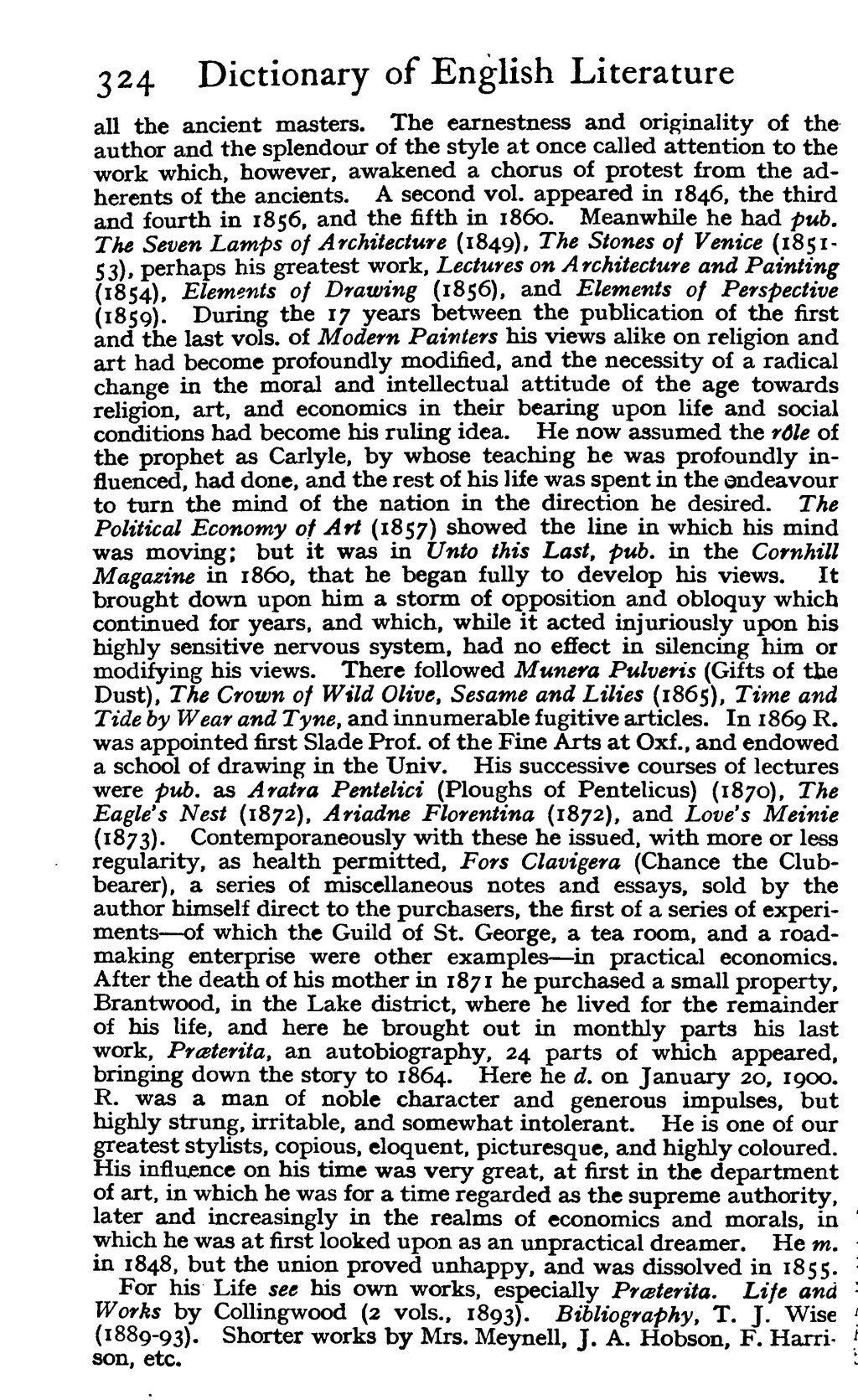all the ancient masters. The earnestness and originality of the author and the splendour of the style at once called attention to the work which, however, awakened a chorus of protest from the adherents of the ancients. A second vol. appeared in 1846, the third and fourth in 1856, and the fifth in 1860. Meanwhile he had pub. "The Seven Lamps of Architecture" (1849), "The Stones of Venice" (1851-53), perhaps his greatest work, Lectures on Architecture and Painting (1854), Elements of Drawing (1856), and Elements of Perspective (1859). During the 17 years between the publication of the first and the last vols. of Modern Painters his views alike on religion and art had become profoundly modified, and the necessity of a radical change in the moral and intellectual attitude of the age towards religion, art, and economics in their bearing upon life and social conditions had become his ruling idea. He now assumed the rôle of the prophet as Carlyle, by whose teaching he was profoundly influenced, had done, and the rest of his life was spent in the endeavour to turn the mind of the nation in the direction he desired. The Political Economy of Art (1857) showed the line in which his mind was moving; but it was in Unto this Last, pub. in the Cornhill Magazine in 1860, that he began fully to develop his views. It brought down upon him a storm of opposition and obloquy which continued for years, and which, while it acted injuriously upon his highly sensitive nervous system, had no effect in silencing him or modifying his views. There followed Munera Pulveris (Gifts of the Dust), The Crown of Wild Olive, Sesame and Lilies (1865), Time and Tide by Wear and Tyne, and innumerable fugitive articles. In 1869 R. was appointed first Slade Prof. of the Fine Arts at Oxf., and endowed a school of drawing in the Univ. His successive courses of lectures were pub. as Aratra Pentelici (Ploughs of Pentelicus) (1870), The Eagle's Nest (1872), Ariadne Florentina (1872), and Love's Meinie (1873). Contemporaneously with these he issued with more or less regularity, as health permitted, Fors Clavigera (Chance the Club-bearer), a series of miscellaneous notes and essays, sold by the author himself direct to the purchasers, the first of a series of experiments—of which the Guild of St. George, a tea room, and a road-making enterprise were other examples—in practical economics. After the death of his mother in 1871 he purchased a small property, Brantwood, in the Lake district, where he lived for the remainder of his life, and here he brought out in monthly parts his last work, "Præterita", an autobiography, 24 parts of which appeared, bringing down the story to 1864. Here hed. on January 20, 1900. R. was a man of noble character and generous impulses, but highly strung, irritable, and somewhat intolerant. He is one of our greatest stylists, copious, eloquent, picturesque, and highly coloured. His influence on his time was very great, at first in the department of art, in which he was for a time regarded as the supreme authority, later and increasingly in the realms of economics and morals, in which he was at first looked upon as an unpractical dreamer. He m. in 1848, but the union proved unhappy, and was dissolved in 1855.
For his Life see his own works, especially "Præterita". Life and Works by Collingwood (2 vols., 1893). Bibliography, T.J. Wise (1889-93). Shorter works by Mrs. Meynell, J.A. Hobson, F. Harrison, etc.
